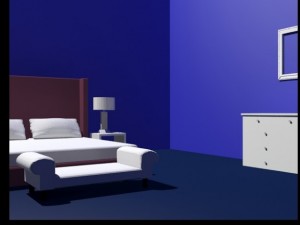RRCP Final Post: Caroline, Soheyla, Olivia
We used the virtual reality technology to design a cruiseship room. Our goal was to find out: Does being in the immersive environment change people’s preferences for room color?
We used the discovery system to rapidly prototype colors in the room and tested the experiment on 40 people. When the participant first arrived to the study, we asked them to fill out a brief questionaire, with questions asking gender, age, visual impairments (color blindness). They were then presented with a grid of paint swatches consisting of 20 colors. We asked them which color they would most likely paint a bedroom according to their color preference. They were then placed in a room with the Discovery System, to test whether their color preference changed when immersed in a virtual reality environment. In the discovery room, we asked the participant to sit in a chair in the middle of the Discovery System monitors, and to wear 3D glasses. Given a playstation controller, we demonstrated to the participant that the D-pad buttons moved you through our room grid. Left and right moved you to rooms of different colors, while up and down moved you to different saturations of the colors. The grid consisted of 20 different rooms with 5 total colors, and four saturations of those five colors. What we hoped to find was that people color preference would change when immersed in a more realistic setting versus solely relying on a paint swatch to choose a room color. We found that participant’s color preferences changed from what they have selected before from the color swatch. Out of 40 total participants that were in our study, only 15% chose the exact same color in the virtual reality system as they had using swatches. 27.5% chose the same color (red, blue, green, purple, or yellow), but chose a different saturation of that color. In contrast, 32.5% chose a different color entirely, but chose the same level of saturation for that color as they had chosen in the paint swatch originally. And lastly, 25% of participants chose an entirely different color, at an entirely different saturation. Our data tells us that being immersed in a virtual reality system is actually helpful in choosing paint selections for interiors.
We all did our best to bring our individual skill sets to the project. As a group and as individuals, we worked on different tasks:
Caroline was key in helping jump-start our project by creating a shared google drive in which we could organize our information, make checklists of tasks, and add helpful information as we worked through our project. In addition to becoming IRB certified, she was fundamental in helping write the IRB. She was a great team member, as she contributed to trouble-shooting our sketch up model, and helped figure out light-baking in 3DS Max.
Soheyla was great in doing research in what was previously studied around this topic. She enlisted the help of a current professor in the field, and met with them to figure out which method was the best way to design our experiment. With prior knowledge on how to use 3DS Max for lighting, Soheyla was helpful in lighting our rooms, and learned how to light-bake, making sure that our rooms looked more realistic to the viewer.
Olivia worked on modeling our rooms. She learned how to use Sketch Up, and constructed 20 rooms with furniture. She chose 20 colors by collecting color swatches, and used those to color each room. Although something weird occurred where she wasn’t able to be added to the IRB, she went through IRB course learning the appropriate ways to conduct a study.
As a group, we worked with each across all areas of the project, meeting with each other on different occasions to work towards creating our experiment.
We’re generally happy about the outcome experiment. We believe the result was really interesting, and matched what we expected. Developing our experiment took longer than we had thought, and we wish we would have been able to get into the Discovery System earlier to work out the kinks we had in our evironment i.e. floating furniture. Overall, we accomplished what we set out to do, so it’s peachy.
Our biggest hurdles were being unfamiliar with the design systems that we had to use in order to accomplish creating our study, such as Sketch Up and 3DS Max. Also, we had also originally wanted to be in the CAVE, but due to scheduling difficulties, it delayed our schedule. Obtaining IRB certification also was a lengthy process, along with writing and submitting it. We also played around with the Emotiv System which turned out to be not as helpful to our experiment as we had hoped. Light baking took some time, as it was a learning curve trying to figure out which lighting would work best, and how to bake it. This, among with other software/coding bugs proved to be our biggest difficulties.
We feel like we met our project goals to a T. We just wish we were able to meet them in a tighter time frame, instead of the lengthy, drawn out process that was our project. Our goals were not always met when it came to deadlines.
If we had more time, we would do…a lot of things. We would work more on the programming side of the experiment, making sure that our space was not 0-gravity-i.e. the furniture was floating and lined up correctly. We would also like to have visual indicators in the system when they were not “in-bounds” of our rooms. We would like to also experiment more with color and potentially wallpaper if we had more time. And of course, more participants would be interesting to test.
Overall, we felt like our experiment has greater potential for color prototyping for interior spaces.


